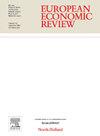揭示欧盟股票和债券投资组合的驱动因素:避税天堂和重力因素的相互作用
IF 2.4
2区 经济学
Q1 ECONOMICS
引用次数: 0
摘要
本文使用结构性资产贸易重力框架,研究了2007年至2017年欧盟内部以及欧盟国家与世界其他国家之间跨境投资组合配置的驱动因素。根据一个数据集,该数据集通过基于国籍原则的投资组合头寸重新映射来纠正避税天堂造成的扭曲,我们估计了一个通过双边和多边阻力项捕获金融摩擦的模型。我们的研究结果表明,引力变量的表现与预期一致:距离减少了持股,而经济规模和历史联系促进了跨境投资。明显的欧盟效应只出现在债券市场,表明存在本土偏见。相比之下,股票持有似乎更具有全球多样性,对金融摩擦也更敏感。与基于居住地的数据的比较证实,未能考虑避税天堂中介削弱了模型拟合,并使关键估计产生偏差。结果在各种估计方法中都是稳健的,并且优于传统的货物贸易重力模型。这些发现强调了在分析国际资产流动时对离岸金融中心进行调整的重要性。本文章由计算机程序翻译,如有差异,请以英文原文为准。
Unveiling the drivers of portfolio equity and bond investment in the European Union: The interplay of tax havens and gravity factors
This paper examines the drivers of cross-border portfolio allocation within the EU and between EU countries and the rest of the world from 2007 to 2017, using a structural asset trade gravity framework. Relying on a dataset that corrects for distortions caused by tax havens through a remapping of portfolio positions based on the nationality principle, we estimate a model in which financial frictions are captured through bilateral and multilateral resistance terms. Our results show that gravity variables perform as expected: distance reduces holdings, while economic size and historical ties promote cross-border investment. A significant EU effect emerges only for bonds, suggesting the presence of a home bias. In contrast, equity holdings appear more globally diversified and sensitive to financial frictions. Comparisons with residence-based data confirm that failing to account for tax haven intermediation weakens model fit and biases key estimates. The results are robust across estimation methods and outperform traditional gravity models for goods trade. These findings highlight the importance of adjusting for offshore financial centers when analyzing international asset flows.
求助全文
通过发布文献求助,成功后即可免费获取论文全文。
去求助
来源期刊

European Economic Review
ECONOMICS-
CiteScore
4.70
自引率
3.60%
发文量
170
期刊介绍:
The European Economic Review (EER) started publishing in 1969 as the first research journal specifically aiming to contribute to the development and application of economics as a science in Europe. As a broad-based professional and international journal, the EER welcomes submissions of applied and theoretical research papers in all fields of economics. The aim of the EER is to contribute to the development of the science of economics and its applications, as well as to improve communication between academic researchers, teachers and policy makers across the European continent and beyond.
 求助内容:
求助内容: 应助结果提醒方式:
应助结果提醒方式:


